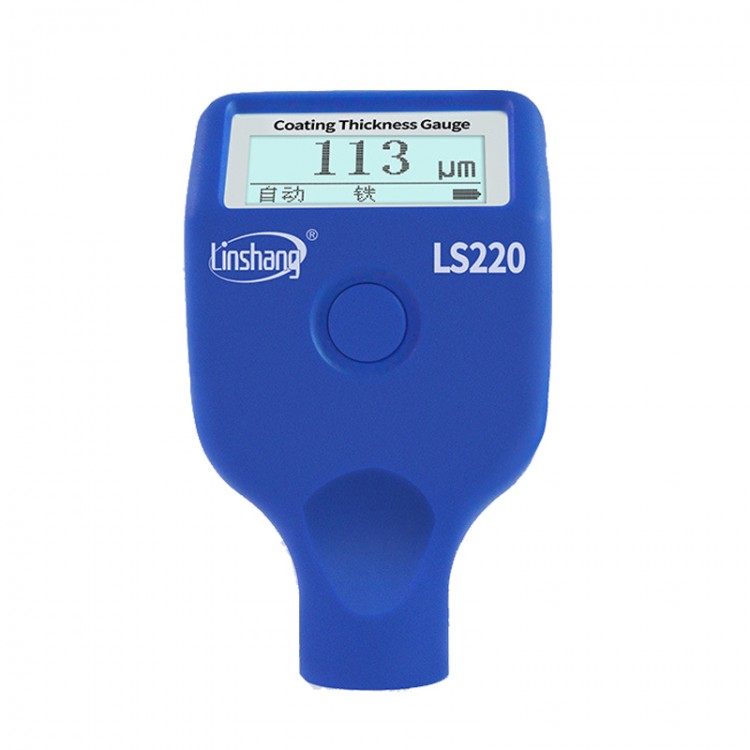
| Quantity | 3+ units | 10+ units | 30+ units | 50+ units | More |
|---|---|---|---|---|---|
| Price /Unit | $137.30 | $134.50 | $130.29 | $124.69 | Contact US |
 FUZRR ES3000P Multifunctional Micro-controller 3-Wire Ground Resistance Tester 0-20Kohms High Precision Earth Resistance Tester
$275.47
FUZRR ES3000P Multifunctional Micro-controller 3-Wire Ground Resistance Tester 0-20Kohms High Precision Earth Resistance Tester
$275.47
 150W Multifunctional Bluetooth Battery Capacity Tester CC/CR/CP/CV/PT/BRT Intelligent DC Programmable Electronic Load
$59.21
150W Multifunctional Bluetooth Battery Capacity Tester CC/CR/CP/CV/PT/BRT Intelligent DC Programmable Electronic Load
$59.21
 FUZRR ES3090E 220A Loop Resistance Tester Micro-ohmmeter for High Voltage Switch Contact Resistance Measurement
$1,466.23
FUZRR ES3090E 220A Loop Resistance Tester Micro-ohmmeter for High Voltage Switch Contact Resistance Measurement
$1,466.23
LS220 Automotive Paint Meter Thickness Coating Thickness Meter 0.0-2000μm LCD Non-Bluetooth Version
LS220 Automotive Paint Meter Introduction:
Automotive paint meter, also called car paint meter, is a special instrument for detecting the automobile substrate surface coating thickness. The covering surface of a car basically has a paint coating. Using an automotive paint meter to measure the paint surface coating thickness can directly determine the sheet metal and spray paint of a car. It can also indirectly determine the damage degree of the car. The LS220 automotive paint meter has small size and is especially suitable for carrying around when going out for inspection. This car paint thickness gauge has the characteristics of fast test speed, stable test data, high measurement accuracy and so on.
LS220 Automotive Paint Meter Application: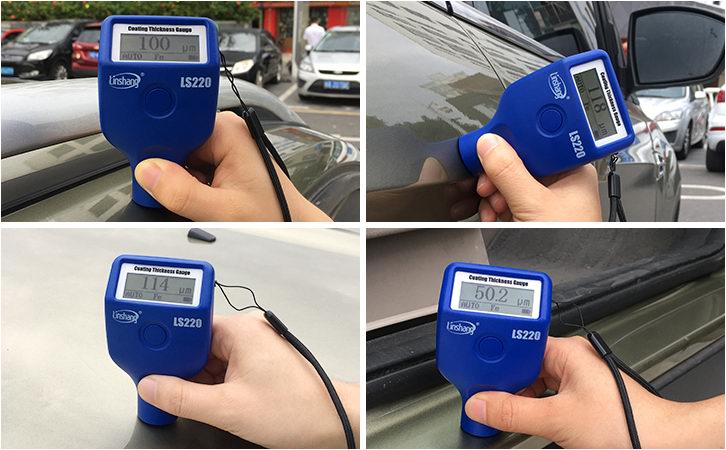
LS220 Automotive Paint Meter Characteristics:
1. The LS220 automotive paint meter has high-sensitivity probe, fast test speed. Measurement can be completed in 0.5 seconds.
2. The LS220 car paint thickness gauge uses dual-purpose probes, which are suitable for detecting the paint thickness on iron materials and also for detecting the paint thickness on aluminum materials. It can also recognize non-metallic substrates.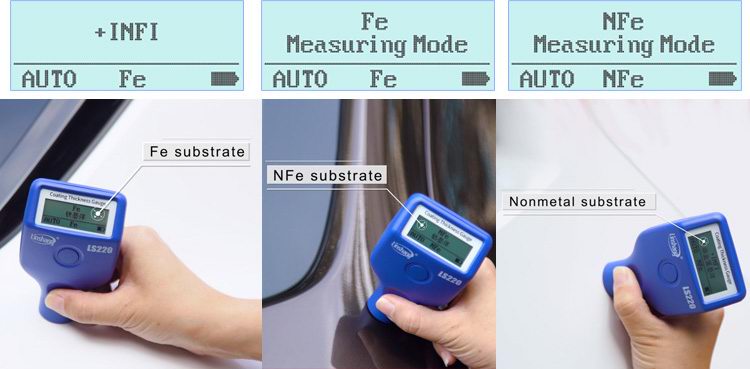
LS220 paint meter for cars can identify the substrate automatically
3. This automotive paint meter uses an industrial-grade LCD screen, which can be used at minus 20℃. No worries for outdoor use in winter of Northern China.
4. No calibration is needed just simple zero adjustment to ensure the measurement accuracy.
5. Wear-proof ruby probe tip for long-term use with strong corrosion and abrasion resistance.
6. With temperature compensation function and digitalizing analog signal function, these sensors are unsusceptible to interference.
7. "Fe", "NFe", "Fe/NFe" three measurement modes can be set for the LS220 automotive paint meter.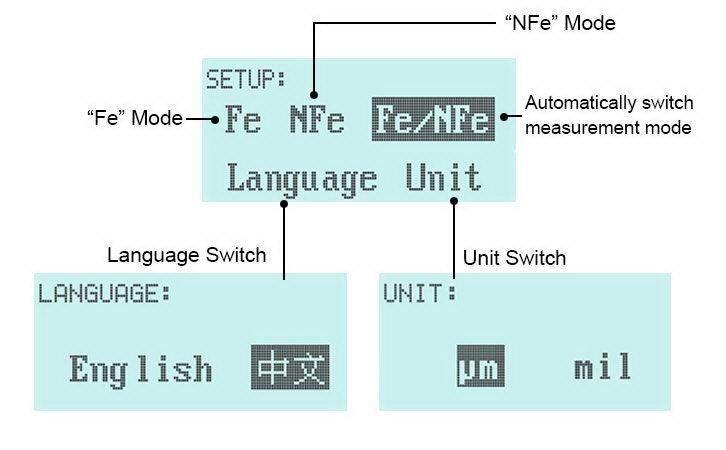
Three Measurement modes of LS220 automotive paint meter
8. Ultra-small size for carrying around when going out for car inspection.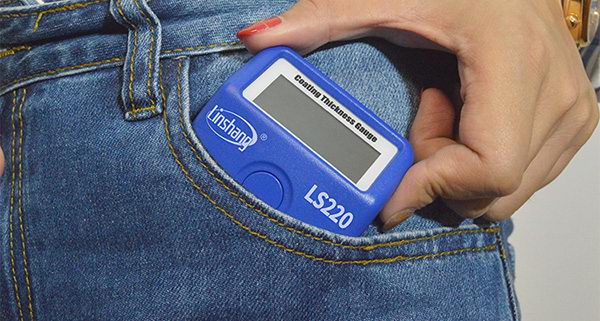
9. Ultra-low power consumption, coupled with the design of automatic shutdown with no operation for 3 minutes to avoid frequent battery replacement and saves energy.
LS220 Automotive Paint Meter Parameters:
- Item name: LS220 Coating Thickness Gauge
- Probe tip: Ruby fixed
- Measuring principle: Fe: Hall Effect / NFe: Eddy current
- Probe type: Built-in integrated probe
- Measuring range: 0.0-2000μm
- Resolution: 0.1μm: (0μm-99.9μm); 1μm:(100μm-999μm); 0.01mm:(1.00mm-2.00mm)
- Accuracy: ≤±(3% reading+2μm)
- Unit: μm/mil
- Measuring interval: 0.5s
- Minimum measuring area: Diameter = 25mm
- Minimum curvature: Convex: 5mm / Concave: 25mm
- Minimum substrate thickness: Fe: 0.2mm / NFe: 0.05mm
- Display: 128×48 dot matrix LCD
- Range of operation temperature: -20℃ to 50℃
- Storage temperature range: -20℃ to 60℃
- Host size: 101*62*28 mm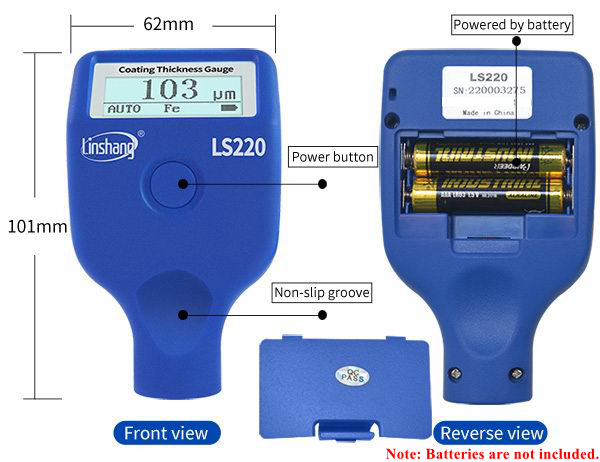
Product Qualification and Standards:
1. LS220 automotive paint meter conforms to the following standards:
* GB/T 4956-2003 Non-magnetic Coatings on Magnetic Substrates-Measurement of Coating Thickness-Magnetic Method
* GB/T 4957-2003 Non-conductive Coatings on Non-magnetic Basis Metals-Measurement of Coating Thickness-Eddy Current
* DIN EN ISO 2808 Paints and Varnishes-Determination of Film Thickness
* JJG-818-2005 Verification Regulation of Magnetic and Eddy Current Measuring Instrument for Coating Thickness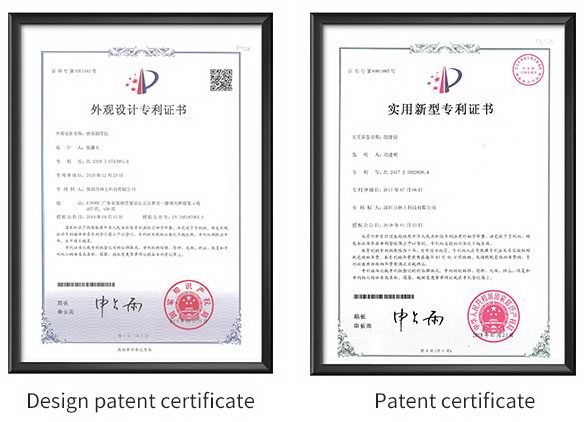
Package Included:
- 1 x Set of Painting Thickness Gauge
Note:
- 2pcs 1.5V AAA alkaline batteries are recommended. Batteries are not included.
FAQ about LS220 Automotive Paint Meter:
1. The difference between LS220 and LS220B car paint meter?
The Bluetooth automotive paint meter LS220B has mobile phone APP. The instrument can be connected to the mobile phone APP through Bluetooth and record test data, while the conventional automotive paint meter LS220 has this function.
2. The difference between LS220 and LS230 car paint meter?
LS230 is an OLED automotive paint meter, which can be used in an environment of minus 40°C, with sensitive response and no lag; while the conventional automotive paint meter LS220 uses a liquid crystal display and the working temperature is -20°C to 60°C.
3. How to judge whether the car has been repainted or not?
At present, the paint thickness of different brands of cars on the market is not exactly the same. Therefore, when measuring the paint film thickness of a certain car, you can first measure the paint thickness on the car roof, because car roof is rarely affected by external forces and scratches, dents or deformation, it is more likely to retain the original paint thickness.
To test the specific position of the car, you can take the upper, lower, left, right, and middle five points to test and calculate the average value of the five data. If the value of one point is greater than the average value of more than 30μm, this position may have been repainted.
4. Under what circumstances we need to make zero adjustment?
When the body material of the car under test changes; the instrument has not been used for a long time; when the ambient temperature changed significantly; after the battery is replaced.